Human Resource Management Report: Equality, Diversity, and Managers
VerifiedAdded on 2022/05/10
|12
|3639
|15
Report
AI Summary
This report delves into the critical aspects of Human Resource Management, specifically focusing on the concepts of equality and diversity within the context of UK businesses. It examines the significance of the Equality Act 2010 and its impact on reducing socio-economic inequalities, emphasizing the protection of employee rights and the prevention of discrimination in recruitment and employment practices. The report also explores the roles and responsibilities of managers in small and medium-sized enterprises (SMEs), highlighting their multifaceted tasks, from strategic planning and employee management to fostering effective communication and project development. The analysis further underscores the benefits of implementing equality and diversity in the workplace, such as increased efficiency, improved problem-solving, and enhanced company image. The report provides real-world examples, such as the Bank of England's initiatives and practices at companies like Unilever and Ocado, to illustrate the practical implications and advantages of embracing diversity and equality in the modern business environment.
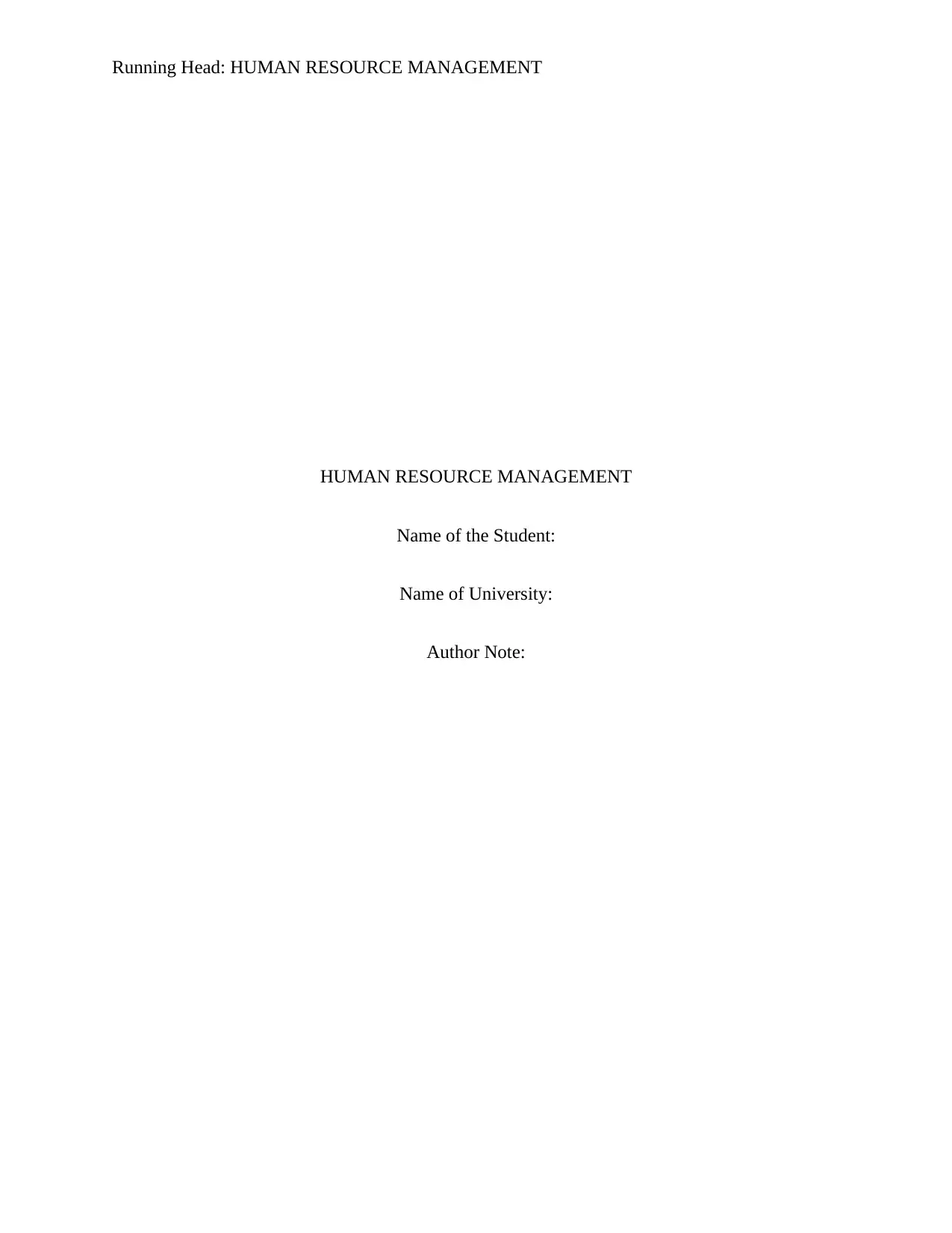
Running Head: HUMAN RESOURCE MANAGEMENT
HUMAN RESOURCE MANAGEMENT
Name of the Student:
Name of University:
Author Note:
HUMAN RESOURCE MANAGEMENT
Name of the Student:
Name of University:
Author Note:
Paraphrase This Document
Need a fresh take? Get an instant paraphrase of this document with our AI Paraphraser
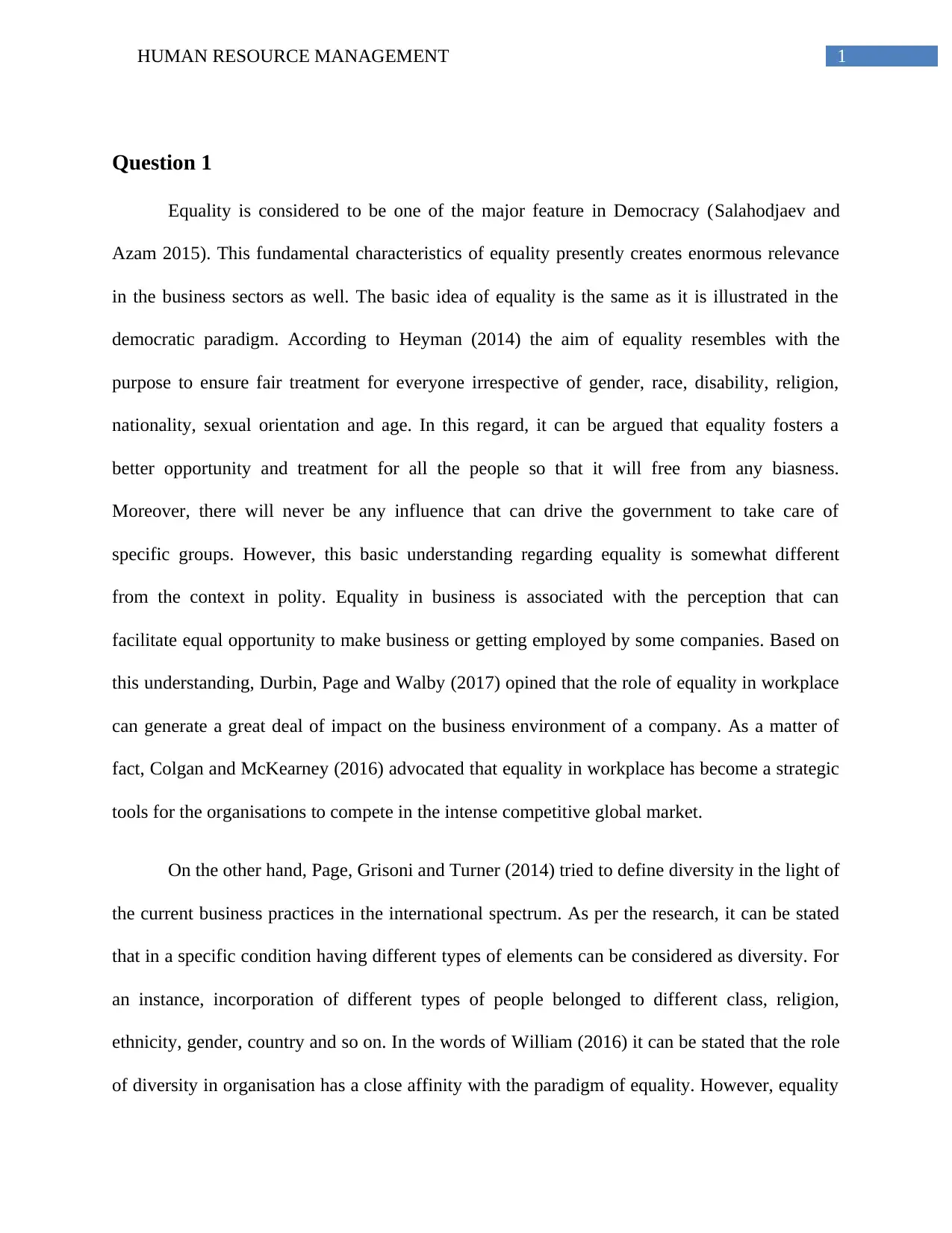
1HUMAN RESOURCE MANAGEMENT
Question 1
Equality is considered to be one of the major feature in Democracy (Salahodjaev and
Azam 2015). This fundamental characteristics of equality presently creates enormous relevance
in the business sectors as well. The basic idea of equality is the same as it is illustrated in the
democratic paradigm. According to Heyman (2014) the aim of equality resembles with the
purpose to ensure fair treatment for everyone irrespective of gender, race, disability, religion,
nationality, sexual orientation and age. In this regard, it can be argued that equality fosters a
better opportunity and treatment for all the people so that it will free from any biasness.
Moreover, there will never be any influence that can drive the government to take care of
specific groups. However, this basic understanding regarding equality is somewhat different
from the context in polity. Equality in business is associated with the perception that can
facilitate equal opportunity to make business or getting employed by some companies. Based on
this understanding, Durbin, Page and Walby (2017) opined that the role of equality in workplace
can generate a great deal of impact on the business environment of a company. As a matter of
fact, Colgan and McKearney (2016) advocated that equality in workplace has become a strategic
tools for the organisations to compete in the intense competitive global market.
On the other hand, Page, Grisoni and Turner (2014) tried to define diversity in the light of
the current business practices in the international spectrum. As per the research, it can be stated
that in a specific condition having different types of elements can be considered as diversity. For
an instance, incorporation of different types of people belonged to different class, religion,
ethnicity, gender, country and so on. In the words of William (2016) it can be stated that the role
of diversity in organisation has a close affinity with the paradigm of equality. However, equality
Question 1
Equality is considered to be one of the major feature in Democracy (Salahodjaev and
Azam 2015). This fundamental characteristics of equality presently creates enormous relevance
in the business sectors as well. The basic idea of equality is the same as it is illustrated in the
democratic paradigm. According to Heyman (2014) the aim of equality resembles with the
purpose to ensure fair treatment for everyone irrespective of gender, race, disability, religion,
nationality, sexual orientation and age. In this regard, it can be argued that equality fosters a
better opportunity and treatment for all the people so that it will free from any biasness.
Moreover, there will never be any influence that can drive the government to take care of
specific groups. However, this basic understanding regarding equality is somewhat different
from the context in polity. Equality in business is associated with the perception that can
facilitate equal opportunity to make business or getting employed by some companies. Based on
this understanding, Durbin, Page and Walby (2017) opined that the role of equality in workplace
can generate a great deal of impact on the business environment of a company. As a matter of
fact, Colgan and McKearney (2016) advocated that equality in workplace has become a strategic
tools for the organisations to compete in the intense competitive global market.
On the other hand, Page, Grisoni and Turner (2014) tried to define diversity in the light of
the current business practices in the international spectrum. As per the research, it can be stated
that in a specific condition having different types of elements can be considered as diversity. For
an instance, incorporation of different types of people belonged to different class, religion,
ethnicity, gender, country and so on. In the words of William (2016) it can be stated that the role
of diversity in organisation has a close affinity with the paradigm of equality. However, equality
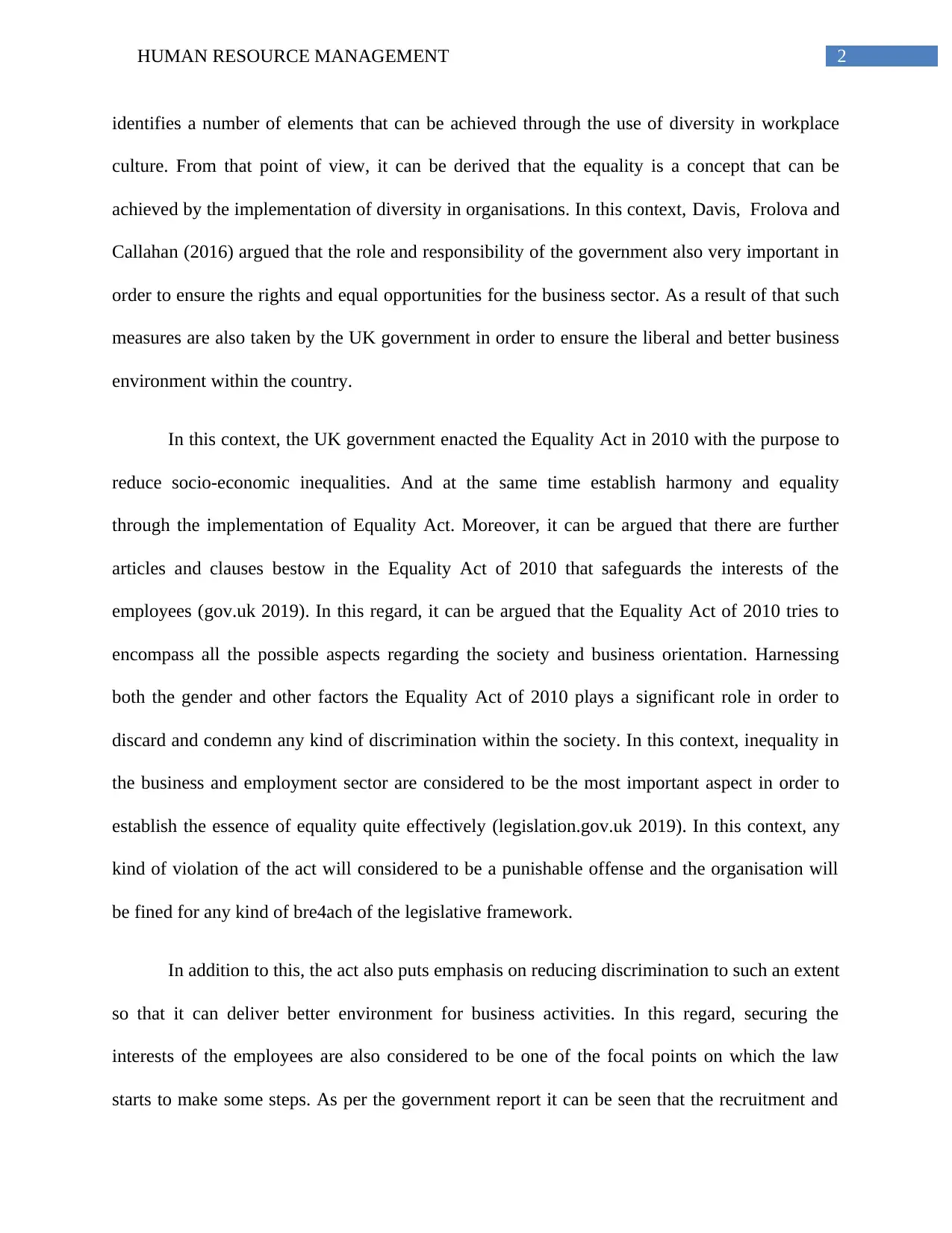
2HUMAN RESOURCE MANAGEMENT
identifies a number of elements that can be achieved through the use of diversity in workplace
culture. From that point of view, it can be derived that the equality is a concept that can be
achieved by the implementation of diversity in organisations. In this context, Davis, Frolova and
Callahan (2016) argued that the role and responsibility of the government also very important in
order to ensure the rights and equal opportunities for the business sector. As a result of that such
measures are also taken by the UK government in order to ensure the liberal and better business
environment within the country.
In this context, the UK government enacted the Equality Act in 2010 with the purpose to
reduce socio-economic inequalities. And at the same time establish harmony and equality
through the implementation of Equality Act. Moreover, it can be argued that there are further
articles and clauses bestow in the Equality Act of 2010 that safeguards the interests of the
employees (gov.uk 2019). In this regard, it can be argued that the Equality Act of 2010 tries to
encompass all the possible aspects regarding the society and business orientation. Harnessing
both the gender and other factors the Equality Act of 2010 plays a significant role in order to
discard and condemn any kind of discrimination within the society. In this context, inequality in
the business and employment sector are considered to be the most important aspect in order to
establish the essence of equality quite effectively (legislation.gov.uk 2019). In this context, any
kind of violation of the act will considered to be a punishable offense and the organisation will
be fined for any kind of bre4ach of the legislative framework.
In addition to this, the act also puts emphasis on reducing discrimination to such an extent
so that it can deliver better environment for business activities. In this regard, securing the
interests of the employees are also considered to be one of the focal points on which the law
starts to make some steps. As per the government report it can be seen that the recruitment and
identifies a number of elements that can be achieved through the use of diversity in workplace
culture. From that point of view, it can be derived that the equality is a concept that can be
achieved by the implementation of diversity in organisations. In this context, Davis, Frolova and
Callahan (2016) argued that the role and responsibility of the government also very important in
order to ensure the rights and equal opportunities for the business sector. As a result of that such
measures are also taken by the UK government in order to ensure the liberal and better business
environment within the country.
In this context, the UK government enacted the Equality Act in 2010 with the purpose to
reduce socio-economic inequalities. And at the same time establish harmony and equality
through the implementation of Equality Act. Moreover, it can be argued that there are further
articles and clauses bestow in the Equality Act of 2010 that safeguards the interests of the
employees (gov.uk 2019). In this regard, it can be argued that the Equality Act of 2010 tries to
encompass all the possible aspects regarding the society and business orientation. Harnessing
both the gender and other factors the Equality Act of 2010 plays a significant role in order to
discard and condemn any kind of discrimination within the society. In this context, inequality in
the business and employment sector are considered to be the most important aspect in order to
establish the essence of equality quite effectively (legislation.gov.uk 2019). In this context, any
kind of violation of the act will considered to be a punishable offense and the organisation will
be fined for any kind of bre4ach of the legislative framework.
In addition to this, the act also puts emphasis on reducing discrimination to such an extent
so that it can deliver better environment for business activities. In this regard, securing the
interests of the employees are also considered to be one of the focal points on which the law
starts to make some steps. As per the government report it can be seen that the recruitment and
⊘ This is a preview!⊘
Do you want full access?
Subscribe today to unlock all pages.

Trusted by 1+ million students worldwide
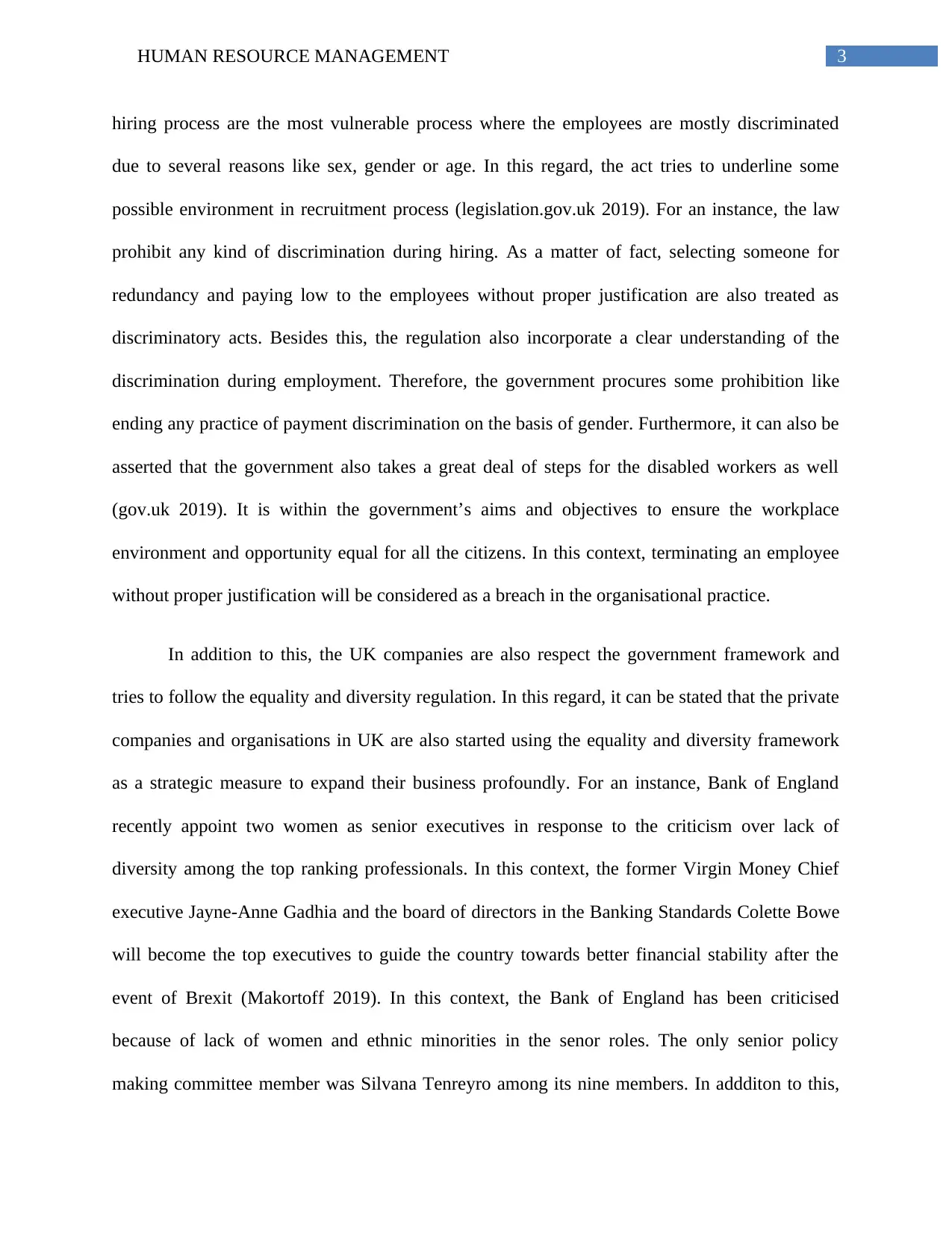
3HUMAN RESOURCE MANAGEMENT
hiring process are the most vulnerable process where the employees are mostly discriminated
due to several reasons like sex, gender or age. In this regard, the act tries to underline some
possible environment in recruitment process (legislation.gov.uk 2019). For an instance, the law
prohibit any kind of discrimination during hiring. As a matter of fact, selecting someone for
redundancy and paying low to the employees without proper justification are also treated as
discriminatory acts. Besides this, the regulation also incorporate a clear understanding of the
discrimination during employment. Therefore, the government procures some prohibition like
ending any practice of payment discrimination on the basis of gender. Furthermore, it can also be
asserted that the government also takes a great deal of steps for the disabled workers as well
(gov.uk 2019). It is within the government’s aims and objectives to ensure the workplace
environment and opportunity equal for all the citizens. In this context, terminating an employee
without proper justification will be considered as a breach in the organisational practice.
In addition to this, the UK companies are also respect the government framework and
tries to follow the equality and diversity regulation. In this regard, it can be stated that the private
companies and organisations in UK are also started using the equality and diversity framework
as a strategic measure to expand their business profoundly. For an instance, Bank of England
recently appoint two women as senior executives in response to the criticism over lack of
diversity among the top ranking professionals. In this context, the former Virgin Money Chief
executive Jayne-Anne Gadhia and the board of directors in the Banking Standards Colette Bowe
will become the top executives to guide the country towards better financial stability after the
event of Brexit (Makortoff 2019). In this context, the Bank of England has been criticised
because of lack of women and ethnic minorities in the senor roles. The only senior policy
making committee member was Silvana Tenreyro among its nine members. In addditon to this,
hiring process are the most vulnerable process where the employees are mostly discriminated
due to several reasons like sex, gender or age. In this regard, the act tries to underline some
possible environment in recruitment process (legislation.gov.uk 2019). For an instance, the law
prohibit any kind of discrimination during hiring. As a matter of fact, selecting someone for
redundancy and paying low to the employees without proper justification are also treated as
discriminatory acts. Besides this, the regulation also incorporate a clear understanding of the
discrimination during employment. Therefore, the government procures some prohibition like
ending any practice of payment discrimination on the basis of gender. Furthermore, it can also be
asserted that the government also takes a great deal of steps for the disabled workers as well
(gov.uk 2019). It is within the government’s aims and objectives to ensure the workplace
environment and opportunity equal for all the citizens. In this context, terminating an employee
without proper justification will be considered as a breach in the organisational practice.
In addition to this, the UK companies are also respect the government framework and
tries to follow the equality and diversity regulation. In this regard, it can be stated that the private
companies and organisations in UK are also started using the equality and diversity framework
as a strategic measure to expand their business profoundly. For an instance, Bank of England
recently appoint two women as senior executives in response to the criticism over lack of
diversity among the top ranking professionals. In this context, the former Virgin Money Chief
executive Jayne-Anne Gadhia and the board of directors in the Banking Standards Colette Bowe
will become the top executives to guide the country towards better financial stability after the
event of Brexit (Makortoff 2019). In this context, the Bank of England has been criticised
because of lack of women and ethnic minorities in the senor roles. The only senior policy
making committee member was Silvana Tenreyro among its nine members. In addditon to this,
Paraphrase This Document
Need a fresh take? Get an instant paraphrase of this document with our AI Paraphraser
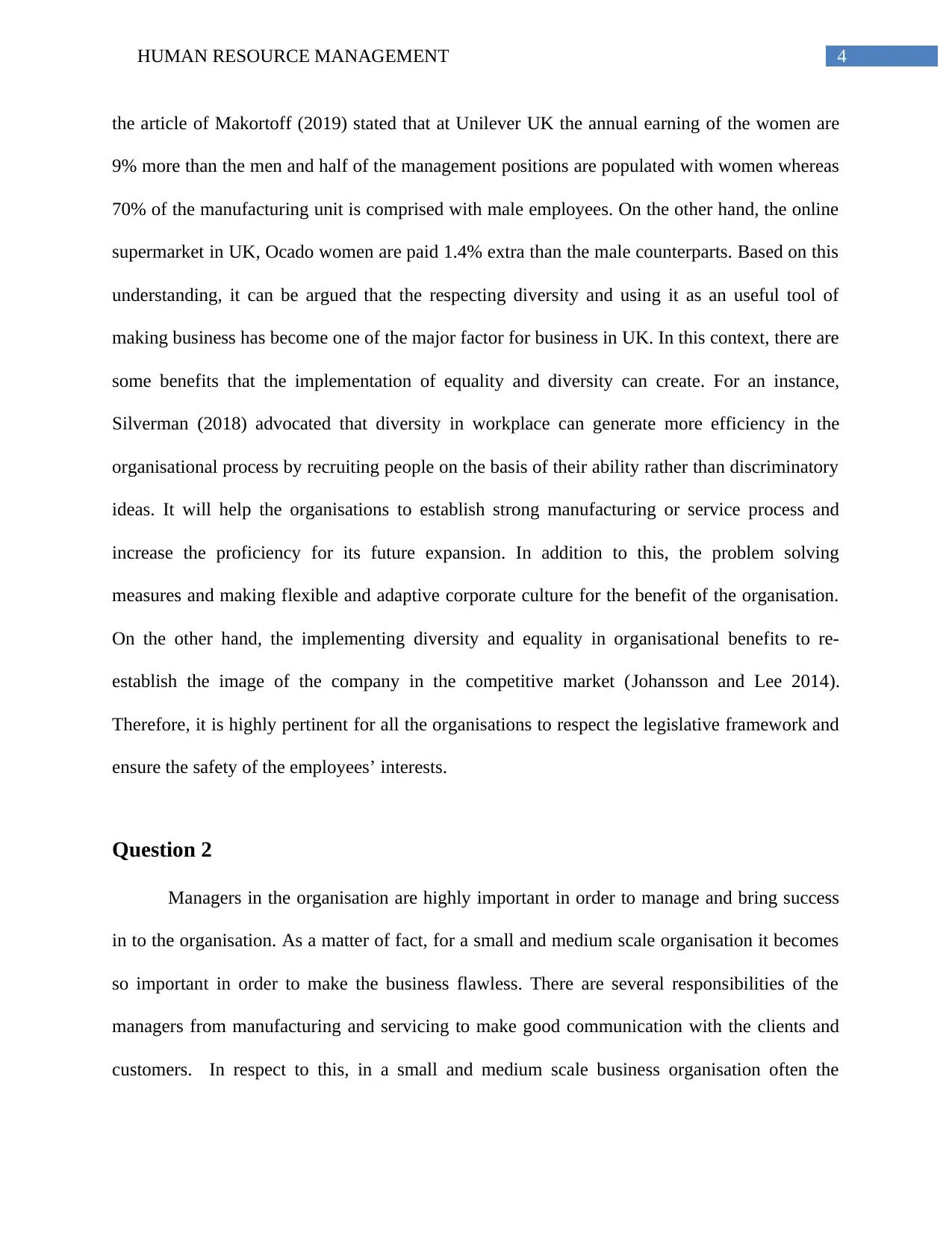
4HUMAN RESOURCE MANAGEMENT
the article of Makortoff (2019) stated that at Unilever UK the annual earning of the women are
9% more than the men and half of the management positions are populated with women whereas
70% of the manufacturing unit is comprised with male employees. On the other hand, the online
supermarket in UK, Ocado women are paid 1.4% extra than the male counterparts. Based on this
understanding, it can be argued that the respecting diversity and using it as an useful tool of
making business has become one of the major factor for business in UK. In this context, there are
some benefits that the implementation of equality and diversity can create. For an instance,
Silverman (2018) advocated that diversity in workplace can generate more efficiency in the
organisational process by recruiting people on the basis of their ability rather than discriminatory
ideas. It will help the organisations to establish strong manufacturing or service process and
increase the proficiency for its future expansion. In addition to this, the problem solving
measures and making flexible and adaptive corporate culture for the benefit of the organisation.
On the other hand, the implementing diversity and equality in organisational benefits to re-
establish the image of the company in the competitive market (Johansson and Lee 2014).
Therefore, it is highly pertinent for all the organisations to respect the legislative framework and
ensure the safety of the employees’ interests.
Question 2
Managers in the organisation are highly important in order to manage and bring success
in to the organisation. As a matter of fact, for a small and medium scale organisation it becomes
so important in order to make the business flawless. There are several responsibilities of the
managers from manufacturing and servicing to make good communication with the clients and
customers. In respect to this, in a small and medium scale business organisation often the
the article of Makortoff (2019) stated that at Unilever UK the annual earning of the women are
9% more than the men and half of the management positions are populated with women whereas
70% of the manufacturing unit is comprised with male employees. On the other hand, the online
supermarket in UK, Ocado women are paid 1.4% extra than the male counterparts. Based on this
understanding, it can be argued that the respecting diversity and using it as an useful tool of
making business has become one of the major factor for business in UK. In this context, there are
some benefits that the implementation of equality and diversity can create. For an instance,
Silverman (2018) advocated that diversity in workplace can generate more efficiency in the
organisational process by recruiting people on the basis of their ability rather than discriminatory
ideas. It will help the organisations to establish strong manufacturing or service process and
increase the proficiency for its future expansion. In addition to this, the problem solving
measures and making flexible and adaptive corporate culture for the benefit of the organisation.
On the other hand, the implementing diversity and equality in organisational benefits to re-
establish the image of the company in the competitive market (Johansson and Lee 2014).
Therefore, it is highly pertinent for all the organisations to respect the legislative framework and
ensure the safety of the employees’ interests.
Question 2
Managers in the organisation are highly important in order to manage and bring success
in to the organisation. As a matter of fact, for a small and medium scale organisation it becomes
so important in order to make the business flawless. There are several responsibilities of the
managers from manufacturing and servicing to make good communication with the clients and
customers. In respect to this, in a small and medium scale business organisation often the
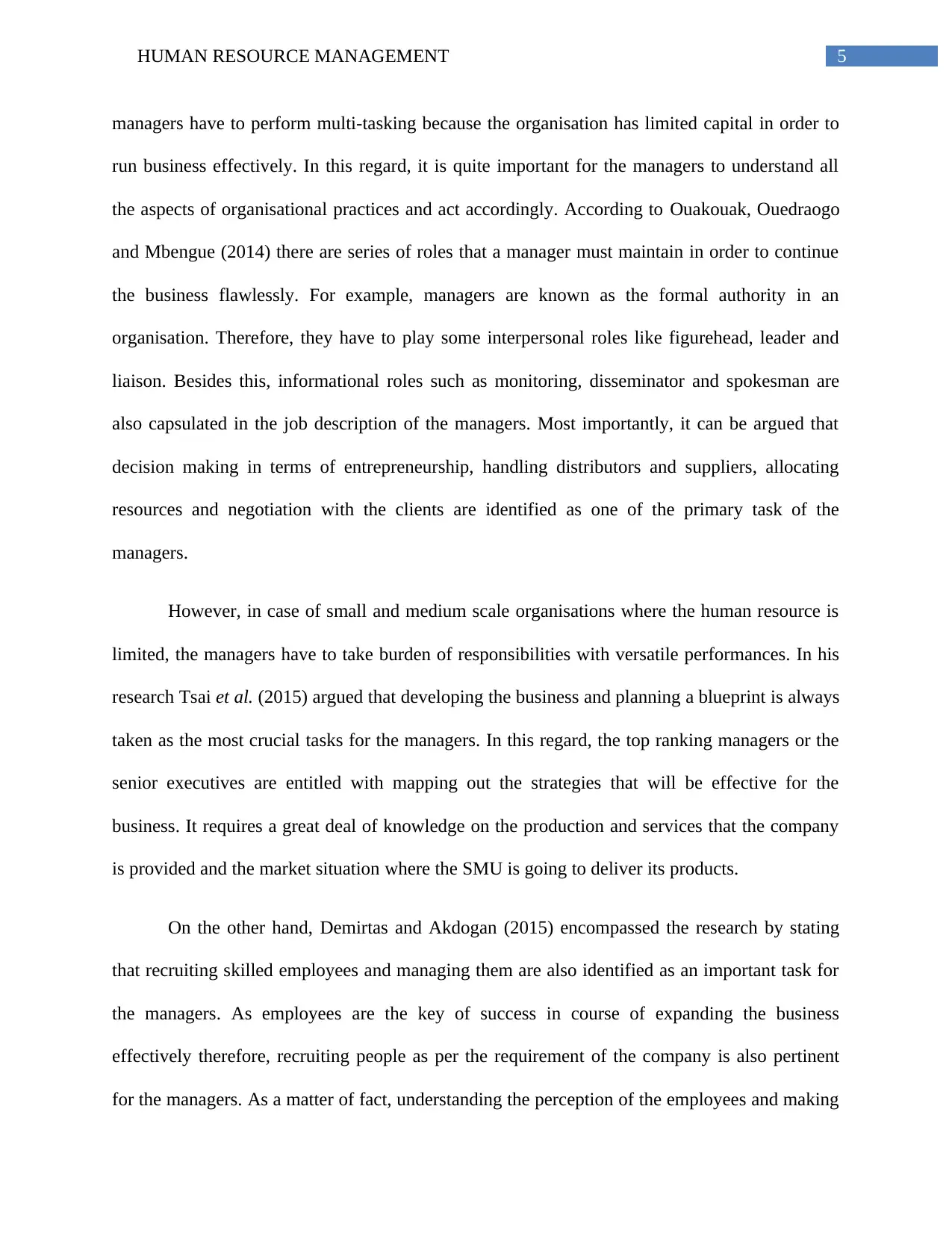
5HUMAN RESOURCE MANAGEMENT
managers have to perform multi-tasking because the organisation has limited capital in order to
run business effectively. In this regard, it is quite important for the managers to understand all
the aspects of organisational practices and act accordingly. According to Ouakouak, Ouedraogo
and Mbengue (2014) there are series of roles that a manager must maintain in order to continue
the business flawlessly. For example, managers are known as the formal authority in an
organisation. Therefore, they have to play some interpersonal roles like figurehead, leader and
liaison. Besides this, informational roles such as monitoring, disseminator and spokesman are
also capsulated in the job description of the managers. Most importantly, it can be argued that
decision making in terms of entrepreneurship, handling distributors and suppliers, allocating
resources and negotiation with the clients are identified as one of the primary task of the
managers.
However, in case of small and medium scale organisations where the human resource is
limited, the managers have to take burden of responsibilities with versatile performances. In his
research Tsai et al. (2015) argued that developing the business and planning a blueprint is always
taken as the most crucial tasks for the managers. In this regard, the top ranking managers or the
senior executives are entitled with mapping out the strategies that will be effective for the
business. It requires a great deal of knowledge on the production and services that the company
is provided and the market situation where the SMU is going to deliver its products.
On the other hand, Demirtas and Akdogan (2015) encompassed the research by stating
that recruiting skilled employees and managing them are also identified as an important task for
the managers. As employees are the key of success in course of expanding the business
effectively therefore, recruiting people as per the requirement of the company is also pertinent
for the managers. As a matter of fact, understanding the perception of the employees and making
managers have to perform multi-tasking because the organisation has limited capital in order to
run business effectively. In this regard, it is quite important for the managers to understand all
the aspects of organisational practices and act accordingly. According to Ouakouak, Ouedraogo
and Mbengue (2014) there are series of roles that a manager must maintain in order to continue
the business flawlessly. For example, managers are known as the formal authority in an
organisation. Therefore, they have to play some interpersonal roles like figurehead, leader and
liaison. Besides this, informational roles such as monitoring, disseminator and spokesman are
also capsulated in the job description of the managers. Most importantly, it can be argued that
decision making in terms of entrepreneurship, handling distributors and suppliers, allocating
resources and negotiation with the clients are identified as one of the primary task of the
managers.
However, in case of small and medium scale organisations where the human resource is
limited, the managers have to take burden of responsibilities with versatile performances. In his
research Tsai et al. (2015) argued that developing the business and planning a blueprint is always
taken as the most crucial tasks for the managers. In this regard, the top ranking managers or the
senior executives are entitled with mapping out the strategies that will be effective for the
business. It requires a great deal of knowledge on the production and services that the company
is provided and the market situation where the SMU is going to deliver its products.
On the other hand, Demirtas and Akdogan (2015) encompassed the research by stating
that recruiting skilled employees and managing them are also identified as an important task for
the managers. As employees are the key of success in course of expanding the business
effectively therefore, recruiting people as per the requirement of the company is also pertinent
for the managers. As a matter of fact, understanding the perception of the employees and making
⊘ This is a preview!⊘
Do you want full access?
Subscribe today to unlock all pages.

Trusted by 1+ million students worldwide
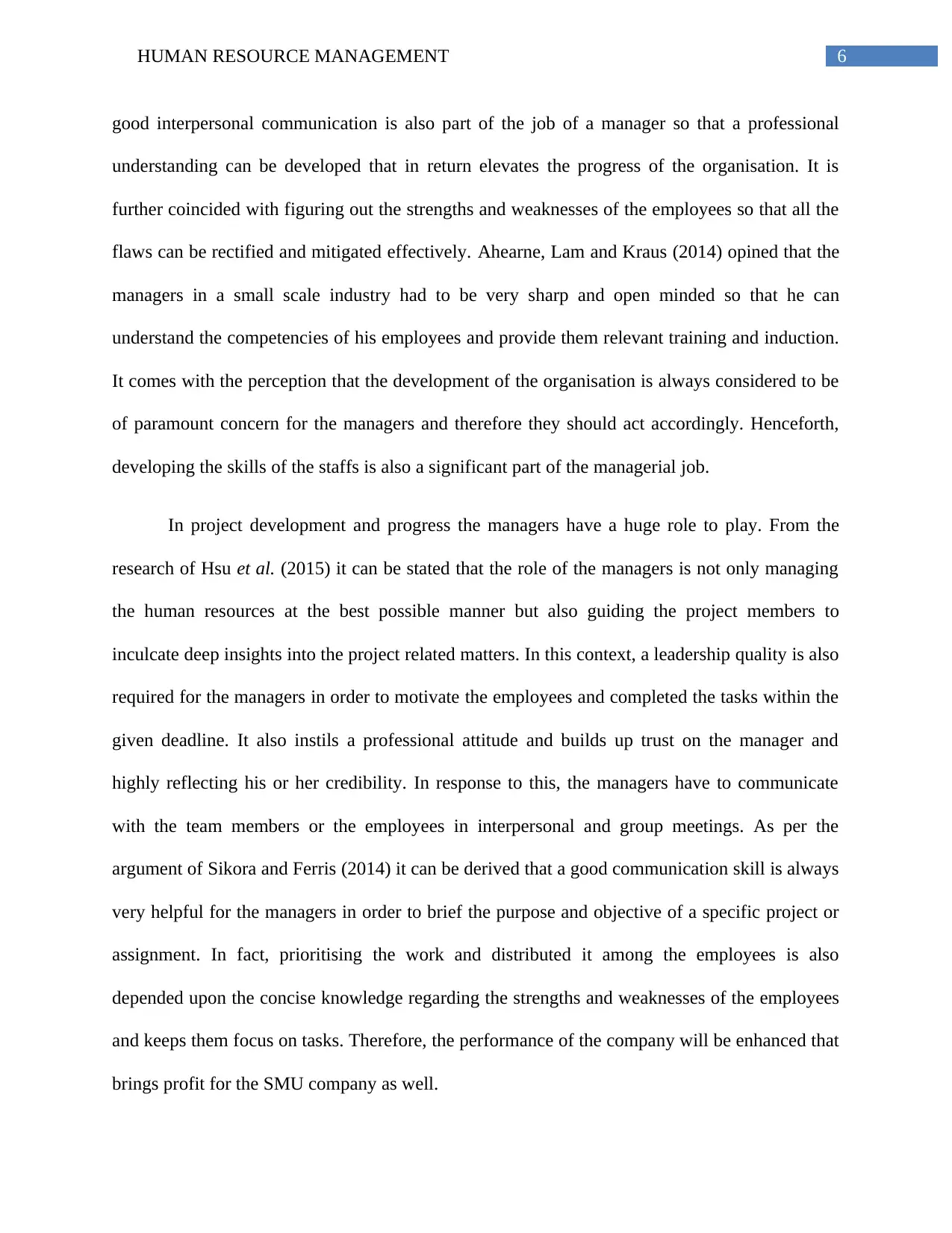
6HUMAN RESOURCE MANAGEMENT
good interpersonal communication is also part of the job of a manager so that a professional
understanding can be developed that in return elevates the progress of the organisation. It is
further coincided with figuring out the strengths and weaknesses of the employees so that all the
flaws can be rectified and mitigated effectively. Ahearne, Lam and Kraus (2014) opined that the
managers in a small scale industry had to be very sharp and open minded so that he can
understand the competencies of his employees and provide them relevant training and induction.
It comes with the perception that the development of the organisation is always considered to be
of paramount concern for the managers and therefore they should act accordingly. Henceforth,
developing the skills of the staffs is also a significant part of the managerial job.
In project development and progress the managers have a huge role to play. From the
research of Hsu et al. (2015) it can be stated that the role of the managers is not only managing
the human resources at the best possible manner but also guiding the project members to
inculcate deep insights into the project related matters. In this context, a leadership quality is also
required for the managers in order to motivate the employees and completed the tasks within the
given deadline. It also instils a professional attitude and builds up trust on the manager and
highly reflecting his or her credibility. In response to this, the managers have to communicate
with the team members or the employees in interpersonal and group meetings. As per the
argument of Sikora and Ferris (2014) it can be derived that a good communication skill is always
very helpful for the managers in order to brief the purpose and objective of a specific project or
assignment. In fact, prioritising the work and distributed it among the employees is also
depended upon the concise knowledge regarding the strengths and weaknesses of the employees
and keeps them focus on tasks. Therefore, the performance of the company will be enhanced that
brings profit for the SMU company as well.
good interpersonal communication is also part of the job of a manager so that a professional
understanding can be developed that in return elevates the progress of the organisation. It is
further coincided with figuring out the strengths and weaknesses of the employees so that all the
flaws can be rectified and mitigated effectively. Ahearne, Lam and Kraus (2014) opined that the
managers in a small scale industry had to be very sharp and open minded so that he can
understand the competencies of his employees and provide them relevant training and induction.
It comes with the perception that the development of the organisation is always considered to be
of paramount concern for the managers and therefore they should act accordingly. Henceforth,
developing the skills of the staffs is also a significant part of the managerial job.
In project development and progress the managers have a huge role to play. From the
research of Hsu et al. (2015) it can be stated that the role of the managers is not only managing
the human resources at the best possible manner but also guiding the project members to
inculcate deep insights into the project related matters. In this context, a leadership quality is also
required for the managers in order to motivate the employees and completed the tasks within the
given deadline. It also instils a professional attitude and builds up trust on the manager and
highly reflecting his or her credibility. In response to this, the managers have to communicate
with the team members or the employees in interpersonal and group meetings. As per the
argument of Sikora and Ferris (2014) it can be derived that a good communication skill is always
very helpful for the managers in order to brief the purpose and objective of a specific project or
assignment. In fact, prioritising the work and distributed it among the employees is also
depended upon the concise knowledge regarding the strengths and weaknesses of the employees
and keeps them focus on tasks. Therefore, the performance of the company will be enhanced that
brings profit for the SMU company as well.
Paraphrase This Document
Need a fresh take? Get an instant paraphrase of this document with our AI Paraphraser
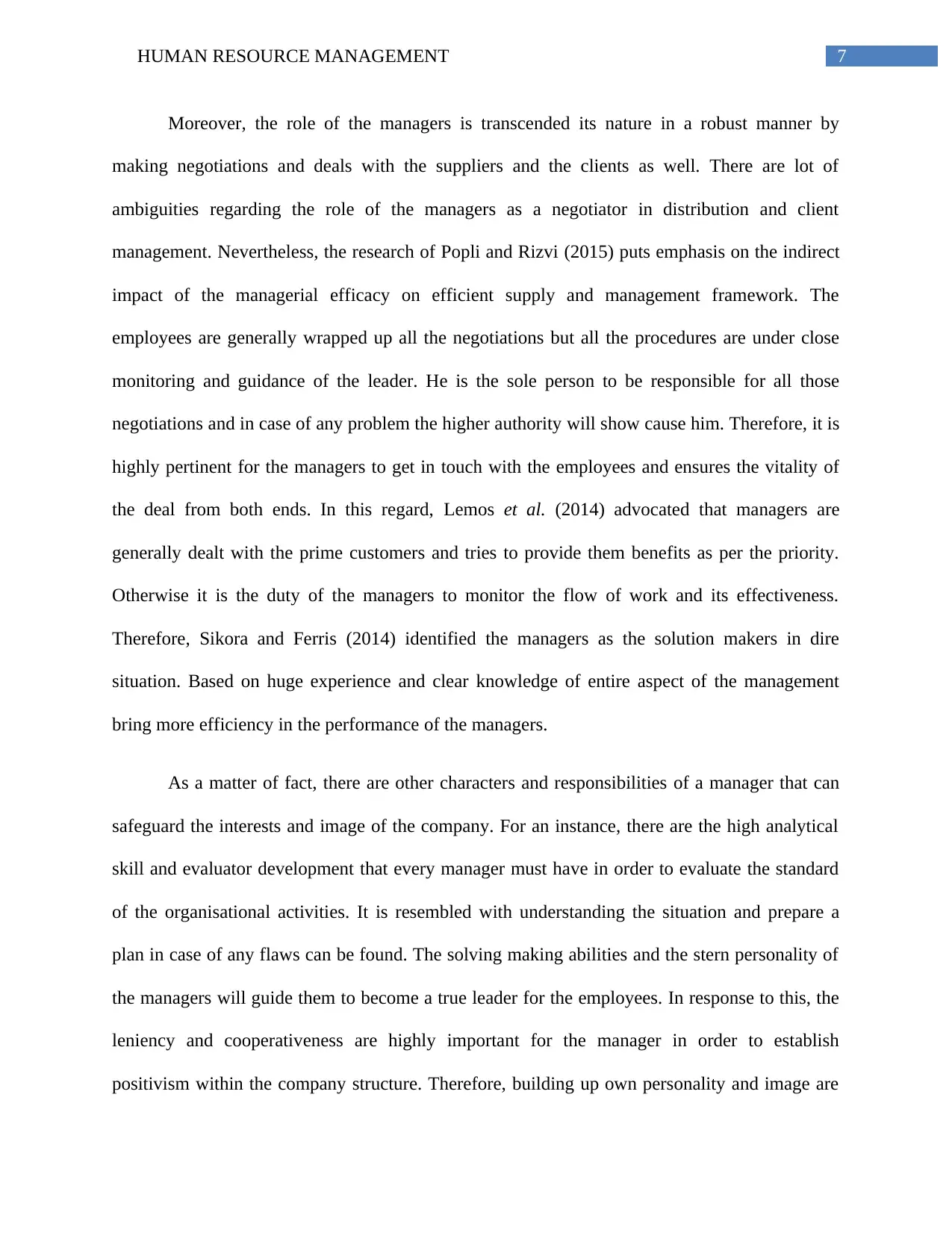
7HUMAN RESOURCE MANAGEMENT
Moreover, the role of the managers is transcended its nature in a robust manner by
making negotiations and deals with the suppliers and the clients as well. There are lot of
ambiguities regarding the role of the managers as a negotiator in distribution and client
management. Nevertheless, the research of Popli and Rizvi (2015) puts emphasis on the indirect
impact of the managerial efficacy on efficient supply and management framework. The
employees are generally wrapped up all the negotiations but all the procedures are under close
monitoring and guidance of the leader. He is the sole person to be responsible for all those
negotiations and in case of any problem the higher authority will show cause him. Therefore, it is
highly pertinent for the managers to get in touch with the employees and ensures the vitality of
the deal from both ends. In this regard, Lemos et al. (2014) advocated that managers are
generally dealt with the prime customers and tries to provide them benefits as per the priority.
Otherwise it is the duty of the managers to monitor the flow of work and its effectiveness.
Therefore, Sikora and Ferris (2014) identified the managers as the solution makers in dire
situation. Based on huge experience and clear knowledge of entire aspect of the management
bring more efficiency in the performance of the managers.
As a matter of fact, there are other characters and responsibilities of a manager that can
safeguard the interests and image of the company. For an instance, there are the high analytical
skill and evaluator development that every manager must have in order to evaluate the standard
of the organisational activities. It is resembled with understanding the situation and prepare a
plan in case of any flaws can be found. The solving making abilities and the stern personality of
the managers will guide them to become a true leader for the employees. In response to this, the
leniency and cooperativeness are highly important for the manager in order to establish
positivism within the company structure. Therefore, building up own personality and image are
Moreover, the role of the managers is transcended its nature in a robust manner by
making negotiations and deals with the suppliers and the clients as well. There are lot of
ambiguities regarding the role of the managers as a negotiator in distribution and client
management. Nevertheless, the research of Popli and Rizvi (2015) puts emphasis on the indirect
impact of the managerial efficacy on efficient supply and management framework. The
employees are generally wrapped up all the negotiations but all the procedures are under close
monitoring and guidance of the leader. He is the sole person to be responsible for all those
negotiations and in case of any problem the higher authority will show cause him. Therefore, it is
highly pertinent for the managers to get in touch with the employees and ensures the vitality of
the deal from both ends. In this regard, Lemos et al. (2014) advocated that managers are
generally dealt with the prime customers and tries to provide them benefits as per the priority.
Otherwise it is the duty of the managers to monitor the flow of work and its effectiveness.
Therefore, Sikora and Ferris (2014) identified the managers as the solution makers in dire
situation. Based on huge experience and clear knowledge of entire aspect of the management
bring more efficiency in the performance of the managers.
As a matter of fact, there are other characters and responsibilities of a manager that can
safeguard the interests and image of the company. For an instance, there are the high analytical
skill and evaluator development that every manager must have in order to evaluate the standard
of the organisational activities. It is resembled with understanding the situation and prepare a
plan in case of any flaws can be found. The solving making abilities and the stern personality of
the managers will guide them to become a true leader for the employees. In response to this, the
leniency and cooperativeness are highly important for the manager in order to establish
positivism within the company structure. Therefore, building up own personality and image are
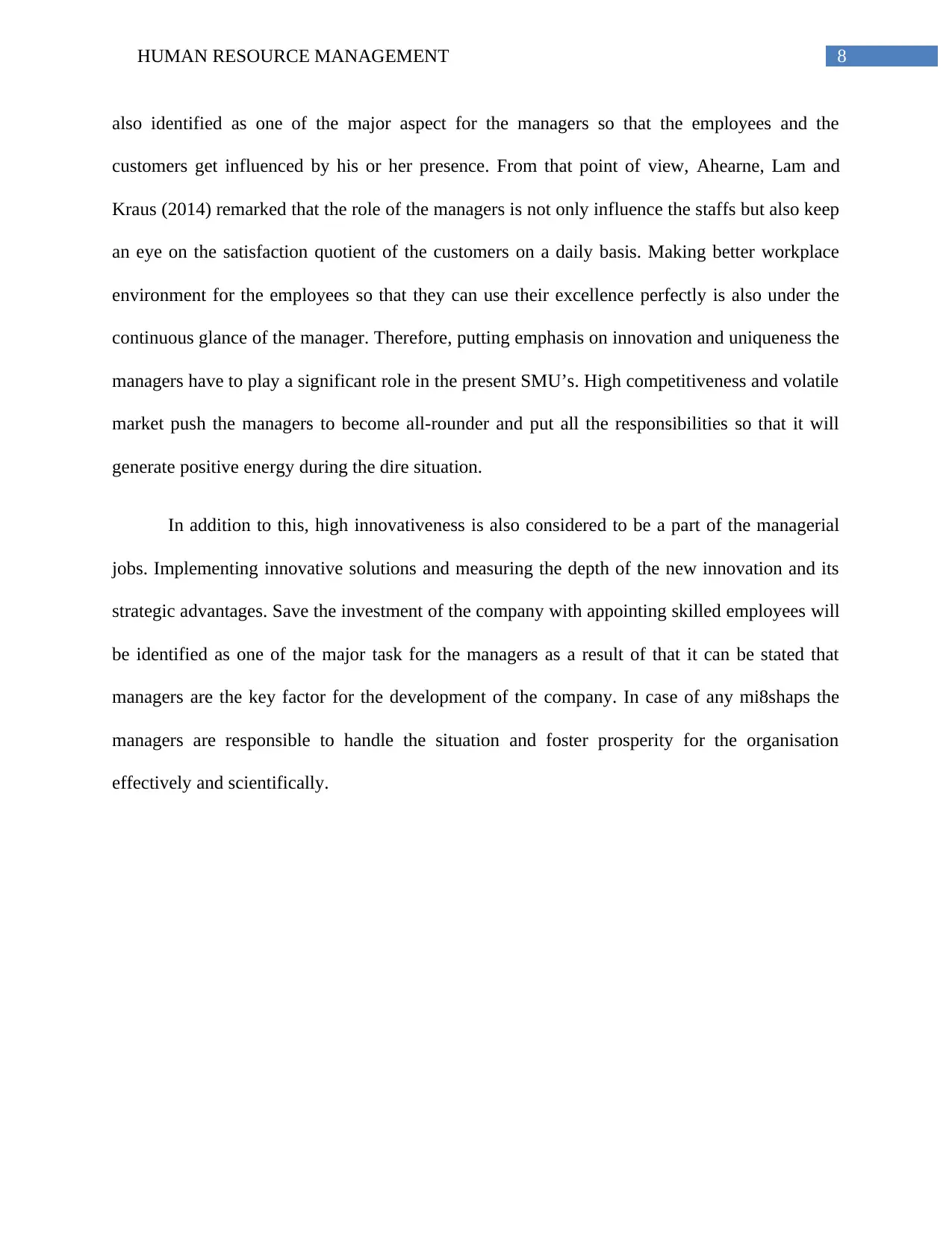
8HUMAN RESOURCE MANAGEMENT
also identified as one of the major aspect for the managers so that the employees and the
customers get influenced by his or her presence. From that point of view, Ahearne, Lam and
Kraus (2014) remarked that the role of the managers is not only influence the staffs but also keep
an eye on the satisfaction quotient of the customers on a daily basis. Making better workplace
environment for the employees so that they can use their excellence perfectly is also under the
continuous glance of the manager. Therefore, putting emphasis on innovation and uniqueness the
managers have to play a significant role in the present SMU’s. High competitiveness and volatile
market push the managers to become all-rounder and put all the responsibilities so that it will
generate positive energy during the dire situation.
In addition to this, high innovativeness is also considered to be a part of the managerial
jobs. Implementing innovative solutions and measuring the depth of the new innovation and its
strategic advantages. Save the investment of the company with appointing skilled employees will
be identified as one of the major task for the managers as a result of that it can be stated that
managers are the key factor for the development of the company. In case of any mi8shaps the
managers are responsible to handle the situation and foster prosperity for the organisation
effectively and scientifically.
also identified as one of the major aspect for the managers so that the employees and the
customers get influenced by his or her presence. From that point of view, Ahearne, Lam and
Kraus (2014) remarked that the role of the managers is not only influence the staffs but also keep
an eye on the satisfaction quotient of the customers on a daily basis. Making better workplace
environment for the employees so that they can use their excellence perfectly is also under the
continuous glance of the manager. Therefore, putting emphasis on innovation and uniqueness the
managers have to play a significant role in the present SMU’s. High competitiveness and volatile
market push the managers to become all-rounder and put all the responsibilities so that it will
generate positive energy during the dire situation.
In addition to this, high innovativeness is also considered to be a part of the managerial
jobs. Implementing innovative solutions and measuring the depth of the new innovation and its
strategic advantages. Save the investment of the company with appointing skilled employees will
be identified as one of the major task for the managers as a result of that it can be stated that
managers are the key factor for the development of the company. In case of any mi8shaps the
managers are responsible to handle the situation and foster prosperity for the organisation
effectively and scientifically.
⊘ This is a preview!⊘
Do you want full access?
Subscribe today to unlock all pages.

Trusted by 1+ million students worldwide
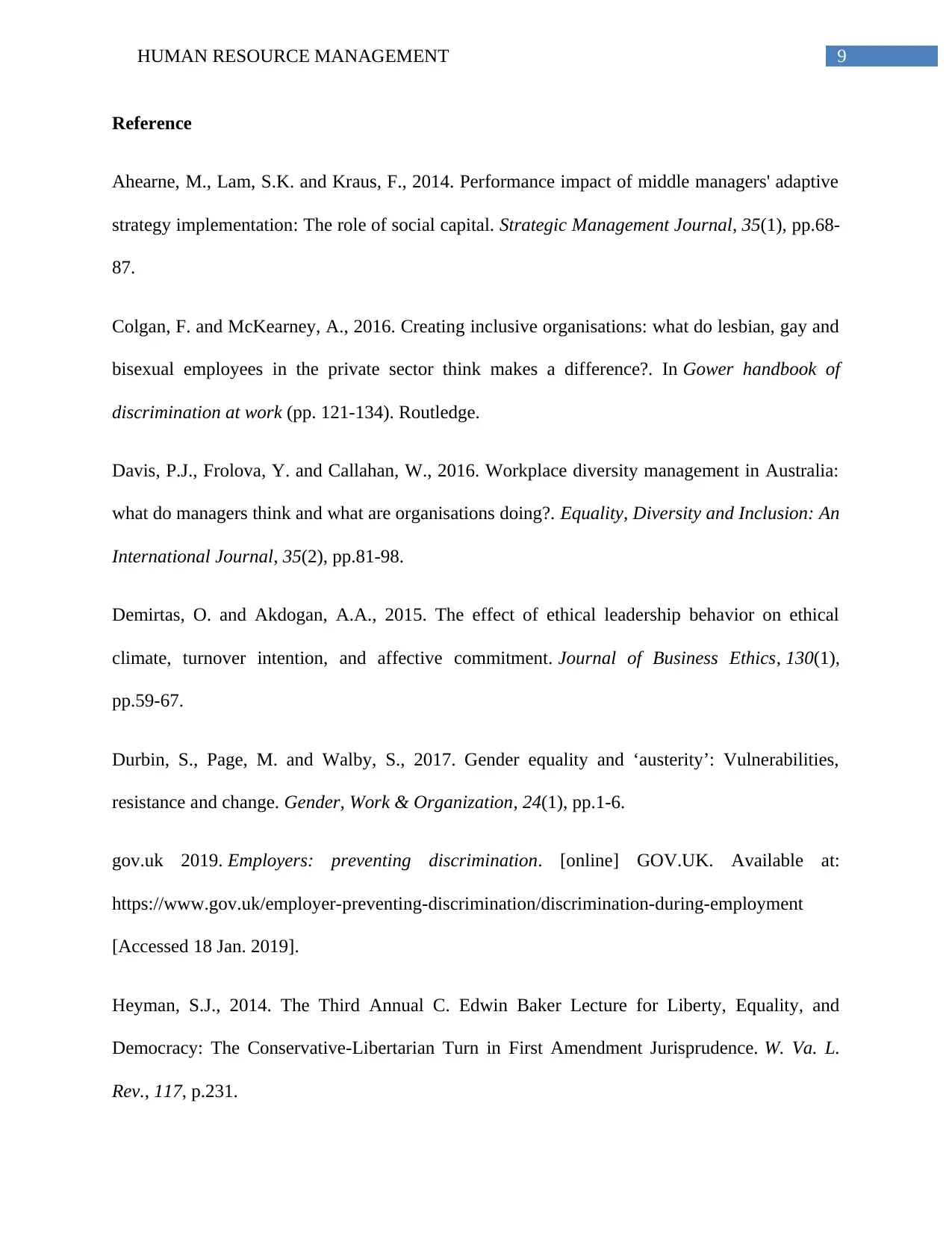
9HUMAN RESOURCE MANAGEMENT
Reference
Ahearne, M., Lam, S.K. and Kraus, F., 2014. Performance impact of middle managers' adaptive
strategy implementation: The role of social capital. Strategic Management Journal, 35(1), pp.68-
87.
Colgan, F. and McKearney, A., 2016. Creating inclusive organisations: what do lesbian, gay and
bisexual employees in the private sector think makes a difference?. In Gower handbook of
discrimination at work (pp. 121-134). Routledge.
Davis, P.J., Frolova, Y. and Callahan, W., 2016. Workplace diversity management in Australia:
what do managers think and what are organisations doing?. Equality, Diversity and Inclusion: An
International Journal, 35(2), pp.81-98.
Demirtas, O. and Akdogan, A.A., 2015. The effect of ethical leadership behavior on ethical
climate, turnover intention, and affective commitment. Journal of Business Ethics, 130(1),
pp.59-67.
Durbin, S., Page, M. and Walby, S., 2017. Gender equality and ‘austerity’: Vulnerabilities,
resistance and change. Gender, Work & Organization, 24(1), pp.1-6.
gov.uk 2019. Employers: preventing discrimination. [online] GOV.UK. Available at:
https://www.gov.uk/employer-preventing-discrimination/discrimination-during-employment
[Accessed 18 Jan. 2019].
Heyman, S.J., 2014. The Third Annual C. Edwin Baker Lecture for Liberty, Equality, and
Democracy: The Conservative-Libertarian Turn in First Amendment Jurisprudence. W. Va. L.
Rev., 117, p.231.
Reference
Ahearne, M., Lam, S.K. and Kraus, F., 2014. Performance impact of middle managers' adaptive
strategy implementation: The role of social capital. Strategic Management Journal, 35(1), pp.68-
87.
Colgan, F. and McKearney, A., 2016. Creating inclusive organisations: what do lesbian, gay and
bisexual employees in the private sector think makes a difference?. In Gower handbook of
discrimination at work (pp. 121-134). Routledge.
Davis, P.J., Frolova, Y. and Callahan, W., 2016. Workplace diversity management in Australia:
what do managers think and what are organisations doing?. Equality, Diversity and Inclusion: An
International Journal, 35(2), pp.81-98.
Demirtas, O. and Akdogan, A.A., 2015. The effect of ethical leadership behavior on ethical
climate, turnover intention, and affective commitment. Journal of Business Ethics, 130(1),
pp.59-67.
Durbin, S., Page, M. and Walby, S., 2017. Gender equality and ‘austerity’: Vulnerabilities,
resistance and change. Gender, Work & Organization, 24(1), pp.1-6.
gov.uk 2019. Employers: preventing discrimination. [online] GOV.UK. Available at:
https://www.gov.uk/employer-preventing-discrimination/discrimination-during-employment
[Accessed 18 Jan. 2019].
Heyman, S.J., 2014. The Third Annual C. Edwin Baker Lecture for Liberty, Equality, and
Democracy: The Conservative-Libertarian Turn in First Amendment Jurisprudence. W. Va. L.
Rev., 117, p.231.
Paraphrase This Document
Need a fresh take? Get an instant paraphrase of this document with our AI Paraphraser
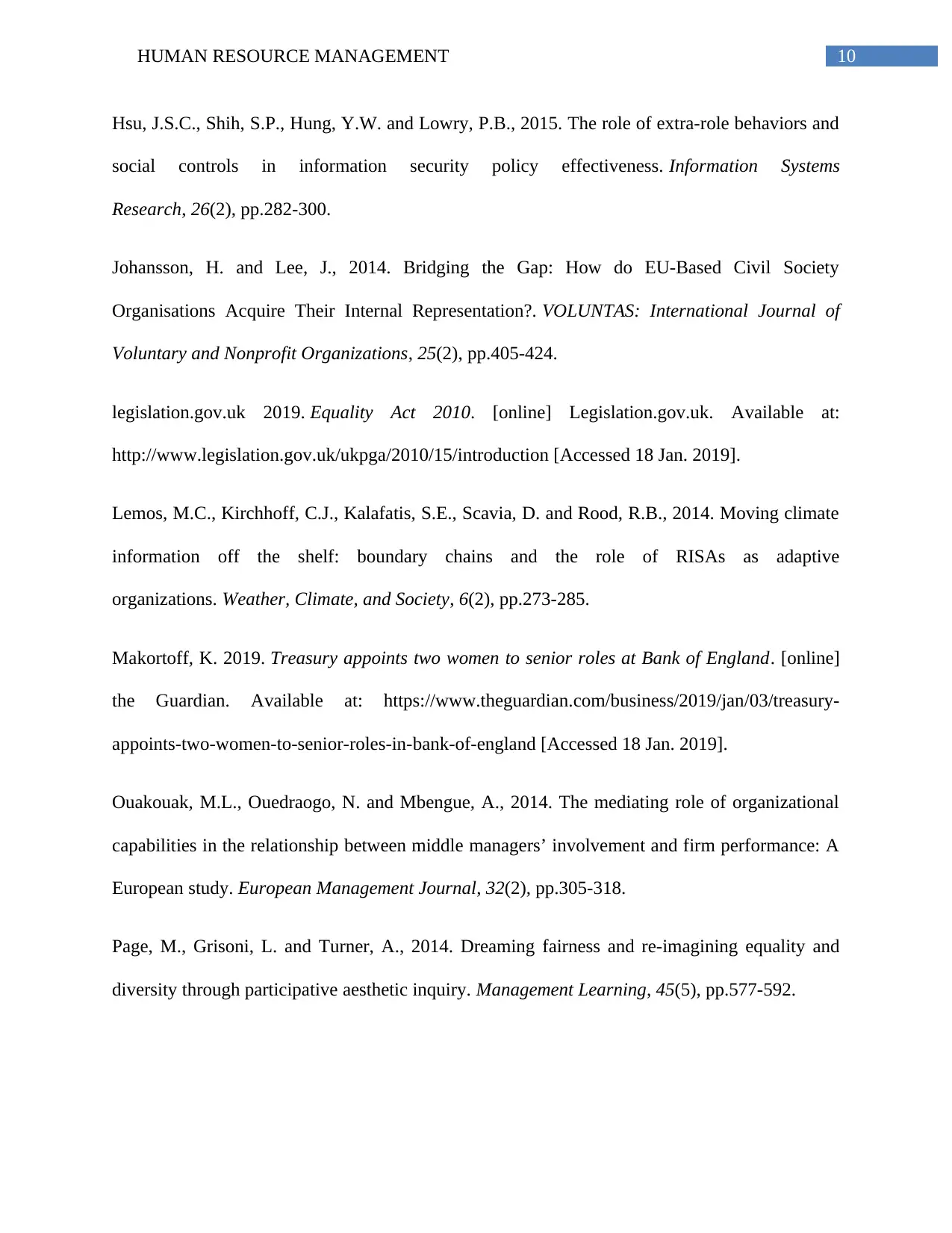
10HUMAN RESOURCE MANAGEMENT
Hsu, J.S.C., Shih, S.P., Hung, Y.W. and Lowry, P.B., 2015. The role of extra-role behaviors and
social controls in information security policy effectiveness. Information Systems
Research, 26(2), pp.282-300.
Johansson, H. and Lee, J., 2014. Bridging the Gap: How do EU-Based Civil Society
Organisations Acquire Their Internal Representation?. VOLUNTAS: International Journal of
Voluntary and Nonprofit Organizations, 25(2), pp.405-424.
legislation.gov.uk 2019. Equality Act 2010. [online] Legislation.gov.uk. Available at:
http://www.legislation.gov.uk/ukpga/2010/15/introduction [Accessed 18 Jan. 2019].
Lemos, M.C., Kirchhoff, C.J., Kalafatis, S.E., Scavia, D. and Rood, R.B., 2014. Moving climate
information off the shelf: boundary chains and the role of RISAs as adaptive
organizations. Weather, Climate, and Society, 6(2), pp.273-285.
Makortoff, K. 2019. Treasury appoints two women to senior roles at Bank of England. [online]
the Guardian. Available at: https://www.theguardian.com/business/2019/jan/03/treasury-
appoints-two-women-to-senior-roles-in-bank-of-england [Accessed 18 Jan. 2019].
Ouakouak, M.L., Ouedraogo, N. and Mbengue, A., 2014. The mediating role of organizational
capabilities in the relationship between middle managers’ involvement and firm performance: A
European study. European Management Journal, 32(2), pp.305-318.
Page, M., Grisoni, L. and Turner, A., 2014. Dreaming fairness and re-imagining equality and
diversity through participative aesthetic inquiry. Management Learning, 45(5), pp.577-592.
Hsu, J.S.C., Shih, S.P., Hung, Y.W. and Lowry, P.B., 2015. The role of extra-role behaviors and
social controls in information security policy effectiveness. Information Systems
Research, 26(2), pp.282-300.
Johansson, H. and Lee, J., 2014. Bridging the Gap: How do EU-Based Civil Society
Organisations Acquire Their Internal Representation?. VOLUNTAS: International Journal of
Voluntary and Nonprofit Organizations, 25(2), pp.405-424.
legislation.gov.uk 2019. Equality Act 2010. [online] Legislation.gov.uk. Available at:
http://www.legislation.gov.uk/ukpga/2010/15/introduction [Accessed 18 Jan. 2019].
Lemos, M.C., Kirchhoff, C.J., Kalafatis, S.E., Scavia, D. and Rood, R.B., 2014. Moving climate
information off the shelf: boundary chains and the role of RISAs as adaptive
organizations. Weather, Climate, and Society, 6(2), pp.273-285.
Makortoff, K. 2019. Treasury appoints two women to senior roles at Bank of England. [online]
the Guardian. Available at: https://www.theguardian.com/business/2019/jan/03/treasury-
appoints-two-women-to-senior-roles-in-bank-of-england [Accessed 18 Jan. 2019].
Ouakouak, M.L., Ouedraogo, N. and Mbengue, A., 2014. The mediating role of organizational
capabilities in the relationship between middle managers’ involvement and firm performance: A
European study. European Management Journal, 32(2), pp.305-318.
Page, M., Grisoni, L. and Turner, A., 2014. Dreaming fairness and re-imagining equality and
diversity through participative aesthetic inquiry. Management Learning, 45(5), pp.577-592.
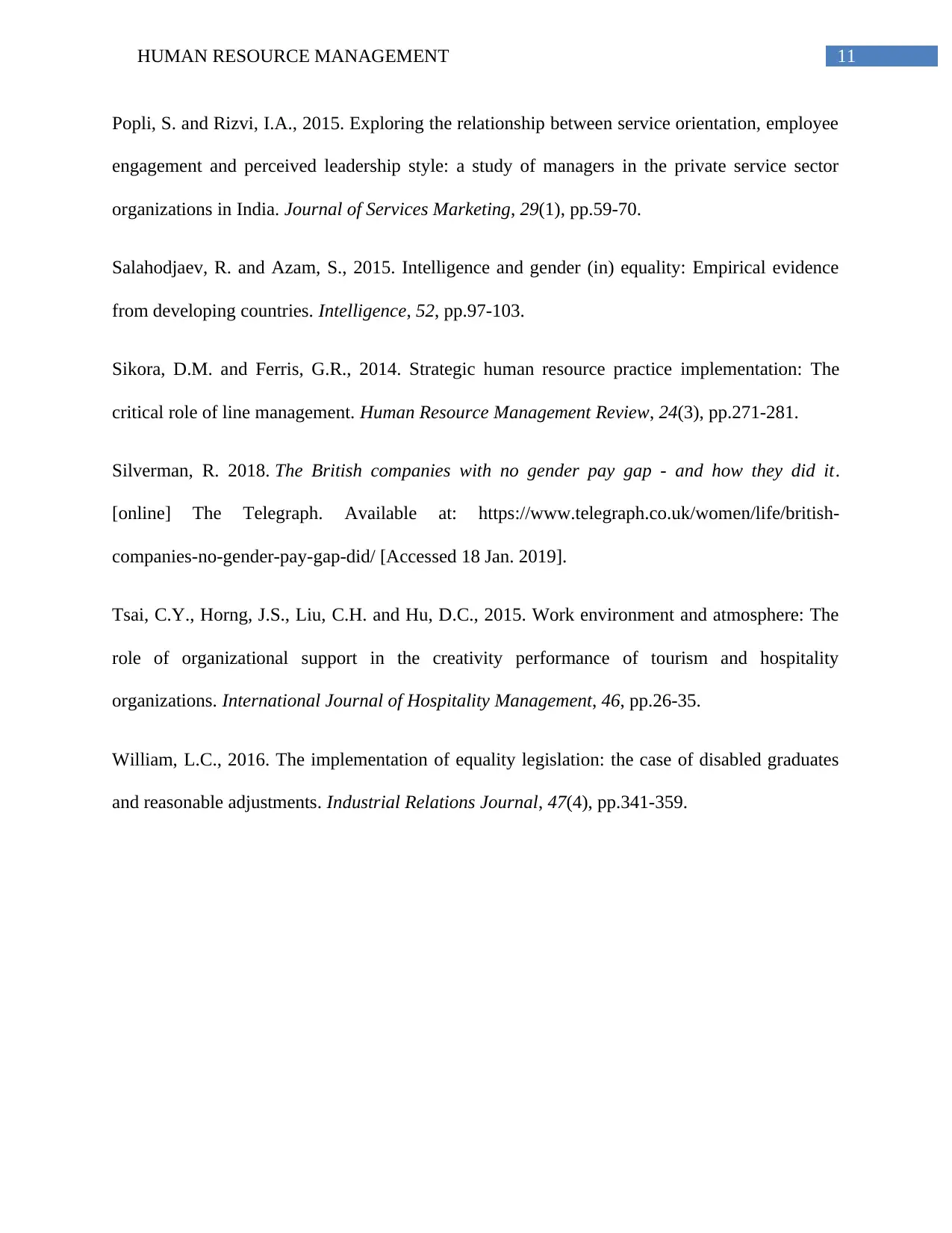
11HUMAN RESOURCE MANAGEMENT
Popli, S. and Rizvi, I.A., 2015. Exploring the relationship between service orientation, employee
engagement and perceived leadership style: a study of managers in the private service sector
organizations in India. Journal of Services Marketing, 29(1), pp.59-70.
Salahodjaev, R. and Azam, S., 2015. Intelligence and gender (in) equality: Empirical evidence
from developing countries. Intelligence, 52, pp.97-103.
Sikora, D.M. and Ferris, G.R., 2014. Strategic human resource practice implementation: The
critical role of line management. Human Resource Management Review, 24(3), pp.271-281.
Silverman, R. 2018. The British companies with no gender pay gap - and how they did it.
[online] The Telegraph. Available at: https://www.telegraph.co.uk/women/life/british-
companies-no-gender-pay-gap-did/ [Accessed 18 Jan. 2019].
Tsai, C.Y., Horng, J.S., Liu, C.H. and Hu, D.C., 2015. Work environment and atmosphere: The
role of organizational support in the creativity performance of tourism and hospitality
organizations. International Journal of Hospitality Management, 46, pp.26-35.
William, L.C., 2016. The implementation of equality legislation: the case of disabled graduates
and reasonable adjustments. Industrial Relations Journal, 47(4), pp.341-359.
Popli, S. and Rizvi, I.A., 2015. Exploring the relationship between service orientation, employee
engagement and perceived leadership style: a study of managers in the private service sector
organizations in India. Journal of Services Marketing, 29(1), pp.59-70.
Salahodjaev, R. and Azam, S., 2015. Intelligence and gender (in) equality: Empirical evidence
from developing countries. Intelligence, 52, pp.97-103.
Sikora, D.M. and Ferris, G.R., 2014. Strategic human resource practice implementation: The
critical role of line management. Human Resource Management Review, 24(3), pp.271-281.
Silverman, R. 2018. The British companies with no gender pay gap - and how they did it.
[online] The Telegraph. Available at: https://www.telegraph.co.uk/women/life/british-
companies-no-gender-pay-gap-did/ [Accessed 18 Jan. 2019].
Tsai, C.Y., Horng, J.S., Liu, C.H. and Hu, D.C., 2015. Work environment and atmosphere: The
role of organizational support in the creativity performance of tourism and hospitality
organizations. International Journal of Hospitality Management, 46, pp.26-35.
William, L.C., 2016. The implementation of equality legislation: the case of disabled graduates
and reasonable adjustments. Industrial Relations Journal, 47(4), pp.341-359.
⊘ This is a preview!⊘
Do you want full access?
Subscribe today to unlock all pages.

Trusted by 1+ million students worldwide
1 out of 12
Related Documents
Your All-in-One AI-Powered Toolkit for Academic Success.
+13062052269
info@desklib.com
Available 24*7 on WhatsApp / Email
![[object Object]](/_next/static/media/star-bottom.7253800d.svg)
Unlock your academic potential
Copyright © 2020–2025 A2Z Services. All Rights Reserved. Developed and managed by ZUCOL.



